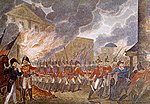Search results
Appearance
There is a page named "Caleb Bentley" on Wikipedia
- Caleb Bentley (1762–1851) was an American silversmith, shopkeeper, and first postmaster in Brookeville, Maryland. Bentley was born in Chester County,...7 KB (700 words) - 04:52, 25 November 2024
- Madison spent the night in the house of Caleb Bentley, a Quaker who lived and worked in Brookeville. Bentley's house, known today as the Madison House...63 KB (6,707 words) - 14:23, 20 February 2025
- along the Reddy Branch, which forms the northern border of the town. Caleb Bentley opened a store and a post office in 1802, becoming the first postmaster...38 KB (4,020 words) - 12:52, 28 January 2025
- feet (240 cm) tall and several had eight-day movements. His brother Caleb Bentley made clocks in Montgomery County, Maryland. "Know Your Antiques". Newspapers...3 KB (237 words) - 04:53, 25 November 2024
- masonic regalia, laid the cornerstone, which was made by silversmith Caleb Bentley. In early 1792, after Pierre L'Enfant was dismissed from the federal...96 KB (9,906 words) - 19:20, 17 February 2025
- Washington on November 17, 1800. President James Madison fled to the home of Caleb Bentley in Brookeville, Maryland following the burning of Washington on August...124 KB (5,154 words) - 01:20, 20 February 2025
- the original on October 18, 2014. Retrieved October 13, 2014. Bell, Caleb; Bentley, Brianna (October 16, 2013). "The Spooky Southeast: Tall Tales of Cleveland...97 KB (9,159 words) - 17:57, 17 February 2025
- organizations. Mary Bentley was born in Maryland to Richard and Edith Bentley, who were Quakers. Her grandfather, Caleb Bentley, was a silversmith and...5 KB (433 words) - 13:01, 10 July 2024
- Corridors", U.S. Capitol Building Oil on canvas First Cornerstone 1793 Caleb Bentley United States Capitol Marble First Reading of the Emancipation Proclamation...369 KB (10,539 words) - 12:02, 21 February 2025
- Lodge of Maryland. A silver plaque, fashioned by Georgetown silversmith Caleb Bentley, was handed to Washington, who stepped into the foundation trench and...15 KB (1,398 words) - 04:51, 9 October 2024
- Isaac Briggs, Thomas Moore, and Revolutionary veteran and silversmith Caleb Bentley built a small town on 276 acres of land with nine houses, sawmill, general...7 KB (607 words) - 01:47, 12 January 2025
- The Madison House in Brookeville, originally owned by Caleb Bentley, provided refuge for President James Madison, on August 26, 1814, after the Burning...51 KB (5,468 words) - 19:35, 24 December 2024
- before 2003, other than having briefly supplied components and engines. The Bentley Motors Limited subsidiary of Volkswagen AG is the direct successor to Rolls-Royce...36 KB (2,868 words) - 22:22, 30 January 2025
- 2016). "Hyundai Snags Bentley Designer Sangyup Lee for Genesis Brand". Motor Trend. Reuters. Retrieved 29 July 2022. Miller, Caleb (April 15, 2022). "Hyundai...10 KB (948 words) - 02:46, 24 October 2024
- Eureka Rebellion (redirect from James Bentley (Eureka Rebellion))1946, pp. 18, 39. Withers 1999, p. 175. Turnbull 1946, p. 40. Ben Reid and Caleb Triscari, Visualising Victoria's Electoral History (Parliament of Victoria...130 KB (16,410 words) - 09:46, 17 February 2025
- Bahr as Iris Reisen Louis Herthum as Louis Sweetzer Caleb Landry Jones as Caleb Sweetzer Tony Bentley as Pastor Manley Shanna Forrestall as Mrs. Marcus...20 KB (2,044 words) - 16:11, 19 February 2025
- Instagram. "Actor Idris Elba Breaks Historic 'Flying Mile' Record in Bentley". Bentley Media. 7 May 2015. Archived from the original on 9 May 2015. Retrieved...82 KB (7,084 words) - 12:43, 21 February 2025
- on political institutions, and Things as They Are; or, The Adventures of Caleb Williams, an early mystery novel which attacks aristocratic privilege. Based...56 KB (6,796 words) - 20:13, 12 January 2025
- Less-Than-Radical Entry in the Cowabunga Canon". Variety. Retrieved June 9, 2024. Bentley, Jean (October 11, 2022). "Boo! Meet the Cast of 'The Curse of Bridge Hollow'"...24 KB (1,179 words) - 16:03, 16 February 2025
- released single, "Mr. Boyd" by Argosy, a quartet that was completed by Caleb Quaye and Nigel Olsson. On the advice of music publisher Steve Brown, John...251 KB (23,090 words) - 13:27, 22 February 2025
- Piracy and Plagiarism.—We have been as a handsome London edition of Dr. Caleb Ticknor's excellent work on medical quackery, which was noticed at length
- by himself. Richard Bentley, p. 511. The two most precious things this side the grave are our reputation and our life. Charles Caleb Colton, p. 511. Character
- Brandon Brendan Brent Brish Bluely Brett/Bret Brian/Bryan Bruce Bryce Byron Caleb Cameron Carlos Carlton Carson Casey Chad Charles/Charlie/Chuck Chase Christian/Chris














